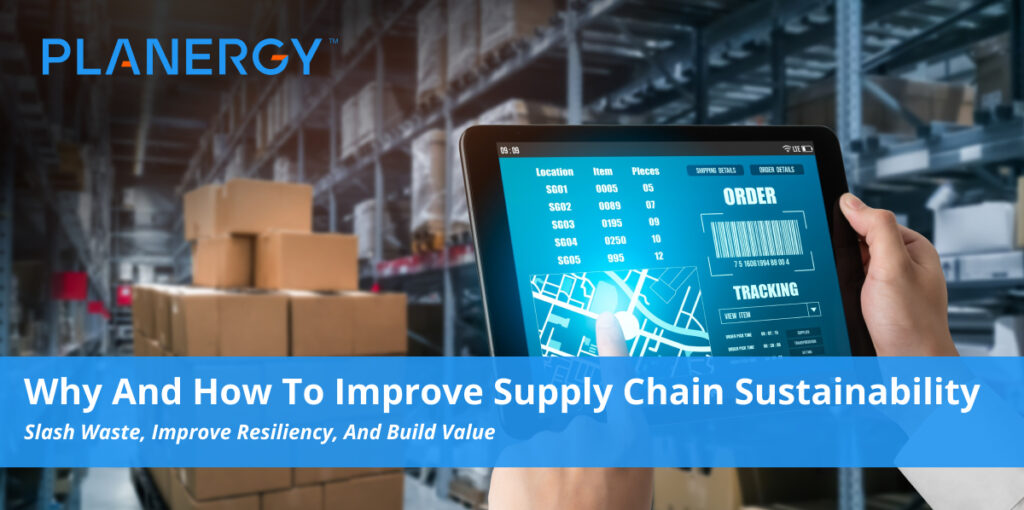Your supply chain is the beating heart of your business; if it fails, your company probably won’t last much longer.
And while a lot of time and effort has been devoted in the age of digital transformation to building supply chains that are more agile, flexible, and resilient, one area hasn’t always been lavished with the same attention: sustainability.
Learning how to improve supply chain sustainability is just as critical as optimizing its efficiency and resiliency. In fact, a sustainable supply chain may prove to be the ultimate source of lasting value, savings, and competitive strength in the future, as global supply chains grow more complex and finding ways to balance strategic sourcing with corporate social responsibility and sustainable practices becomes critical to success.
What is Supply Chain Sustainability?
Basic supply chain management dictates that companies should look for suppliers who provide them with the best possible quality, service, and reliability with the lowest possible risk and pricing.
But doing business in today’s economy requires consideration of other factors, including:
- The environmental impact generated by those supply chains, including issues such as the use of landfills vs recycled materials and whether suppliers at all tiers (primary, secondary, tertiary, etc.) offer renewable resources or comply with sustainable practices.
- The ways in which global climate change and human behavior combine to affect logistics, the availability of raw materials, and overall environmental health (e.g. deforestation, the creation of acid rain, carbon emissions/greenhouse gas emissions, etc.).
- Business models incorporating sustainability practices (e.g. sustainable procurement) in order to build a strong value chain and enhance profitability while meeting customer expectations, legal and industry requirements, and an organization’s own standards for sustainability, continuous improvement, and corporate social responsibility.
For example, automaker Subaru has pioneered a zero-waste business model for its factory in Indiana, and global logistics titan UPS has introduced a suite of packaging design, vehicle modification, and corporate social responsibility initiatives as part of its larger sustainability strategy. - Opportunities to integrate new materials and technologies that support a circular economy.
Companies establish and implement supply chain sustainability programs in order to address these concerns.
The goal is to ensure they’re able to compete effectively, optimize processes, secure cost savings, and practice agile and resilient supply chain management that supports a healthy bottom line while incorporating best practices that improve their organizations’ environmental footprint.
Ensuring suppliers at all levels comply with your organization’s standards for sustainability and meet your performance indicators for environmental performance requires more than good intentions.
Why Knowing How to Improve Supply Chain Sustainability Matters
Whether they produce consumer goods, operate as retailers, or provide goods and services to other businesses, every organization has an opportunity to evolve their business model to incorporate sustainable practices and reduce their carbon footprint.
Increasingly, this opportunity is itself evolving into an obligation, as both consumers and government bodies come to recognize the importance of sustainability efforts in curbing global climate change and reducing the environmental impact that comes with doing business—and demand companies adjust their supply chain strategies and business practices accordingly.
Prioritizing sustainability has a powerful positive impact on organizational efficiency and efficacy, too. Environmentally responsible choices that cut waste and streamline processes using renewable materials and automation technologies can have an organization-wide impact, as does implementing software solutions that center procurement as the company’s primary source of insight-driven process improvements and strategic insights.
In addition, sustainability helps insulate companies against lost value and growth susceptible to the ravages of a compromised global climate. Deforestation, greenhouse gas emissions, water shortages, and labor violations/worker health and safety issues are just some of the threats to future value that can be mitigated by effective sustainability programs.
And, of course, environmental threats aren’t the only supply chain risks in need of mitigation. A sustainable supply chain also helps provide the resilience and flexibility companies are looking for as the global economy begins to emerge from the shadow of the COVID-19 novel coronavirus pandemic.
The more efficient, green, and resource-savvy your supply chain, the more agile and responsive your company will be in adapting to the new normal.
This includes new paradigms like a remote workforce that doesn’t generate the expenses that come with a formal headquarters, but does need technology, sustainable materials and tools, and reliable, efficient access to information in order to get the job done from home.
That said, while awareness of the need for stability is easily gained, actually integrating sustainable business processes into your overall operational paradigm can be challenging. A 2020 study conducted by Harvard Business Review found even well-established multinational corporations (MNCs) with robust supply chains had difficulty achieving sustainable supply chains.
And in fact, several respondents suffered scandals caused by compliance and performance issues with first tier suppliers, with the problems worsening as they moved down through secondary and tertiary tiers.
Ensuring suppliers at all levels comply with your organization’s standards for sustainability and meet your performance indicators for environmental performance requires more than good intentions.
The digital global economy is driven by data, and it is through effective data collection, management, and analysis—along with process automation—that companies stand a stronger chance of identifying and collaborating with suppliers who can meet their needs for economic and environmental performance.
Finally, both customers and investors are willing to put their money where their mouth is when it comes to sustainability. Nearly half (46%) of investors surveyed by Gallup in 2020 said they were either somewhat or very interested in sustainable investing.
A 2019 survey conducted by Accenture found more than half of consumers are willing to pay more for sustainable products designed to be reused, recycled, or both, and 81% said they expected to buy more environmentally friendly products over the next five years.
Best Practices for Achieving Supply Chain Sustainability
There’s no one-size-fits-all approach to achieving supply chain sustainability.
But companies large and small can craft achievable sustainability goals and develop the sustainable business processes necessary to support them by following a few basic best practices.
1. Invest in Digital Procurement
Every area of your business is touched by procurement. Every department, every project team, every business unit and satellite office needs goods and services.
And because procurement is responsible for supply chain management, supplier relationship management, and (when working with stakeholders from accounts payable, finance, and other areas), spend management, making sure your procurement function has the best possible data management, analysis, and automation tools is the first step to crafting and enforcing sustainable strategies for sourcing.
Implementing a modular, centralized, and cloud-based solution such as PLANERGY makes it easy to optimize and streamline your entire procure-to-pay (P2P) process.
In the bargain, you gain powerful process automation, complete data visibility and transparency, and access to data analysis tools that enable your team to target and collaborate with suppliers who meet your high standards for sustainable business practices and compliance with industry and legal standards for environmental responsibility.
Analyzing spend data (both historical and current) gives leaders real-time access to forecasts, reports, and data models they can use to balance supply chain sustainability with supply chain resilience and agility.
A robust supplier management module allows for full integration with supplier systems (further improving data completeness and process automation) and convenient tracking for key performance indicators and other metrics.
2. Craft a Sustainable Supply Chain Strategy
While the three MNCs tracked in the Harvard Business Review’s 2020 study targeted different markets, their approaches to ensuring their supply base shared their commitments to environmental and social responsibility shared certain commonalities.
Each company:
- Set and documented clear, long-term goals for sustainability.
- Documented long-term sustainability goals established by first-tier/primary suppliers.
- Included and collaborated with lower-tier suppliers in establishing their overall sustainability strategies.
- Created a dedicated team or position to implement and enforce the company’s sustainability program within all levels of the supply chain.
These four practices provide a firm foundation for any company interested in achieving best-in-class supply chain sustainability as part of its overall business strategy.
Guided by these practices, companies can work with their own suppliers to:
- Establish the benchmarks and metrics used to measure compliance with sustainability strategies.
- Determine timelines for adopting industry standards for sustainability.
- Perform audits to help both new and existing suppliers get on board with standards for emissions, sustainable sourcing from their own suppliers, renewable materials, etc.
- Identify interdependencies and potential areas of increased risk within each layer of the supply chain, and develop strategies to eliminate or mitigate those risks.
- Look for opportunities to introduce automation, artificial intelligence (including machine learning), and analytics to suppliers through procurement optimization, increasing efficiency and providing a richer data pool for shared innovation, product development, strategic sourcing, etc.\
- Connect through industry associations and sustainability initiatives to achieve greater sustainability and efficiency, as well as access shared resources such as training.
Beyond prioritizing collaboration and shared success, successful sustainability strategies address internal practices and look for opportunities to integrate environmental awareness, renewability, and social responsibility at all stages of the value chain.
Examples include:
- Finding ways to reduce packaging and delivery costs through greater efficiency, renewable materials, and reduced material usage. Cereal giant Post leveraged local sourcing to produce its Weetabix cereal using wheat harvested less than 50 miles from the plant manufacturing it.
To cite another example, the meat replacement products produced by Beyond Meat use 99% less water, 93% less land, and create 90% less greenhouse emissions than their traditional counterparts. The company adds to the savings and further reduces its environmental impact by using minimal packing that is curbside recyclable. - Leveraging automation and practicing proactive resource management (e.g., reusing water, reclaiming and recycling waste materials, switching to green technologies to provide power, etc.) to optimize operational processes. For example, PepsiCo not only saved itself more than $80 million through proactive water conservation between 2011 and 2015, but reduced its water footprint by 40 million liters between 2017 and 2019. They have set a target of having net water positive impact by 2023.
The company also replenished locally an estimated 1.6 billion gallons of fresh water in 2019, while also engaging in corporate social responsibility through multiple programs bringing fresh drinking and wash water to impoverished communities and developing water-efficient agricultural programs.
Tech giant Apple has implemented its own “planet-size plan” for sustainability. The company achieved carbon neutrality in 2020 (reducing its carbon footprint by 4.3 billion metric tons), and is on course for all of its products to be carbon neutral by 2030. The company has set ambitious goals for using 100% renewable and recycled materials in all of its products and packaging, and “closed the loop” on its paper supply chain, with 100% of wood fiber in its paper and packaging sourced from recycled or responsible sources. - Integrating circular economy models into operational and business processes to reduce resource consumption and eliminate waste. For example, shoe company Timberland reclaims old tires for use in manufacturing their iconic boots, while power supply company Clarios (formerly Johnson Controls) developed batteries that are 99% recyclable, providing a steady stream of materials for new production while keeping toxic chemicals out of landfills to reduce environmental impact.
3. Practice Proactive Change Management
Similar to digital transformation, sustainability initiatives may require substantial investment in education, training, and change management in order to bring your organization up to speed, secure buy-in from all stakeholders, and update or develop processes you can use to measure and improve compliance.
Sharing case studies that highlight the value, cost savings, and reputational benefits that come with sustainability practices can help build excitement, and over time, sharing the positive impact of sustainability initiatives within the organization can sustain it.
Invest in training for new team members and suppliers to underscore the importance of sustainability within your organization, and prepare educational materials that can be shared with new and existing customers to demonstrate your commitment to environmental stewardship and social responsibility.
Remember, too, that sustainability is a marathon, not a sprint. The same data management and analysis tools that provide strategic sourcing insights can be used to benchmark and evaluate the ongoing success of your sustainability efforts.
They can also help you analyze emerging trends, changing consumer and market behaviors, and evolving environmental conditions to develop new sustainability initiatives to meet the challenges that lie beyond the horizon.
Make a Sustainable Supply Chain Part of Your Plan for Sourcing Success
From combating climate change to finding ways to navigate the new normal following the COVID-19 pandemic, your supply chain is more than just a pipeline for raw materials, goods, and services.
By developing your own sustainability strategies and leveraging data tools and technologies to identify and collaborate with like-minded suppliers, you can build a supply chain that minimizes your carbon footprint while still providing you with the benefits of agility and resilience.
You’ll more easily integrate continuous improvement into your processes, meet your goals for profitability, performance, and corporate social responsibility, and uncover new opportunities for innovation, cost savings, and enhancing your competitive advantage.




